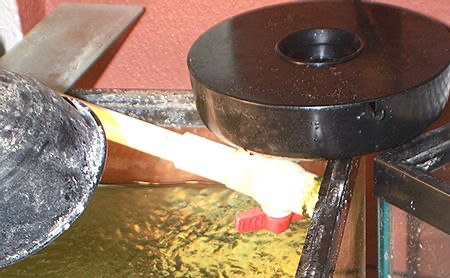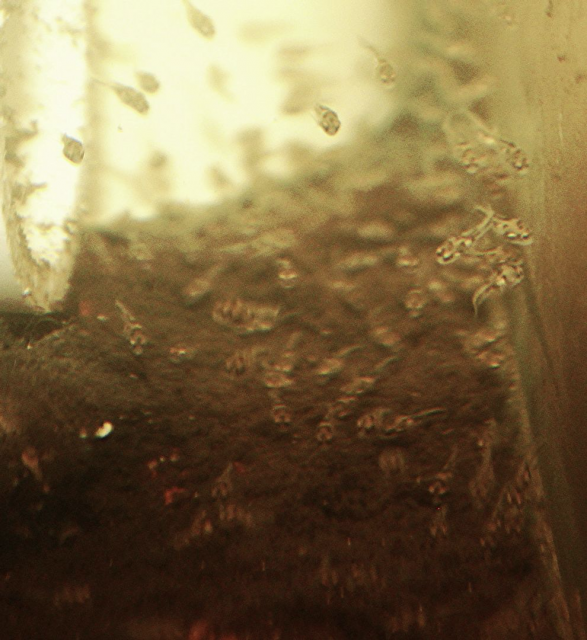So this may be incredibly stupid but I honestly don’t know. When you get fry do they require a cycled sponge filter or does it not matter if it’s cycled or not? I swear I’ve seen some people throw in an uncycled sponge in a fry tank. If they don’t require it to be cycled is it because their waste output is so low that the bb on the sponge keeps up with the growth of the fry?
Fry tank question
- Thread starter fishhead0103666
- Start date
Hello; Good question and your observation may be correct about the fry releasing very little ammonia, at least for a while.
However, to me , there are other things going on. One thing I do if I have fertile eggs is to start an infusoria (sp) culture. I boil some water with lettuce leaves in it. Usually around a gallon. I let that sit around a few days. If I start the infusioria (sp) the same day eggs are laid they both start to meet at about the right time.
My technique has been to start a fry tank with maybe only a third of the water it will hold in total. That way I can start adding some of the infusoria culture when the fry begin to star being free swimming. I just pour in a little of the culture including bits of lettuce. The fry can and do find things to feed on. As time goes by I can add more culture or other fry foods.
I can also add fresh water for a while until the tank is full. My thinking being this dilutes the water with fresh during a time when it is difficult to siphon out water without risking getting some fry. With luck by the time a tank gets full the fry are big enough that I can put a fine screen over a siphon tube and drain out the old water.
About the new sponge vs. a mature sponge. I like to use a mature sponge in a fry tank. My thinking has been two fold. One is the culture and other foods from decay along with the fry themselves will create some ammonia. So the sponge will have beneficial bacteria (bb) to take care of such. The other is I have seen fry grazing on the surface of a mature sponge. They find something to feed on.
However, to me , there are other things going on. One thing I do if I have fertile eggs is to start an infusoria (sp) culture. I boil some water with lettuce leaves in it. Usually around a gallon. I let that sit around a few days. If I start the infusioria (sp) the same day eggs are laid they both start to meet at about the right time.
My technique has been to start a fry tank with maybe only a third of the water it will hold in total. That way I can start adding some of the infusoria culture when the fry begin to star being free swimming. I just pour in a little of the culture including bits of lettuce. The fry can and do find things to feed on. As time goes by I can add more culture or other fry foods.
I can also add fresh water for a while until the tank is full. My thinking being this dilutes the water with fresh during a time when it is difficult to siphon out water without risking getting some fry. With luck by the time a tank gets full the fry are big enough that I can put a fine screen over a siphon tube and drain out the old water.
About the new sponge vs. a mature sponge. I like to use a mature sponge in a fry tank. My thinking has been two fold. One is the culture and other foods from decay along with the fry themselves will create some ammonia. So the sponge will have beneficial bacteria (bb) to take care of such. The other is I have seen fry grazing on the surface of a mature sponge. They find something to feed on.
^Hello; Good question and your observation may be correct about the fry releasing very little ammonia, at least for a while.
However, to me , there are other things going on. One thing I do if I have fertile eggs is to start an infusoria (sp) culture. I boil some water with lettuce leaves in it. Usually around a gallon. I let that sit around a few days. If I start the infusioria (sp) the same day eggs are laid they both start to meet at about the right time.
My technique has been to start a fry tank with maybe only a third of the water it will hold in total. That way I can start adding some of the infusoria culture when the fry begin to star being free swimming. I just pour in a little of the culture including bits of lettuce. The fry can and do find things to feed on. As time goes by I can add more culture or other fry foods.
I can also add fresh water for a while until the tank is full. My thinking being this dilutes the water with fresh during a time when it is difficult to siphon out water without risking getting some fry. With luck by the time a tank gets full the fry are big enough that I can put a fine screen over a siphon tube and drain out the old water.
About the new sponge vs. a mature sponge. I like to use a mature sponge in a fry tank. My thinking has been two fold. One is the culture and other foods from decay along with the fry themselves will create some ammonia. So the sponge will have beneficial bacteria (bb) to take care of such. The other is I have seen fry grazing on the surface of a mature sponge. They find something to feed on.
This
Agree with skjl47, with constant feedings, waste output (even though they are small) the large numbers will be putting out plenty of toxic mmonia, and because their bodily systems are under developed they will need the mature sponge to neutralize it, unless you do daily massive water changes (80%-90%). And in any spawn there will be a certain % that don't make it, adding the ammonia from decomposition, unless noticed right away
I usually have my fry grow out tanks in series with the main tanks on a sump, so in this way water changes on the main tank also effect the fry tanks, and so while removing water from the entire system doesn't inadvertantly suck up fry, and new water added hits the sump first, and blends before hitting the fry tank


I usually have my fry grow out tanks in series with the main tanks on a sump, so in this way water changes on the main tank also effect the fry tanks, and so while removing water from the entire system doesn't inadvertantly suck up fry, and new water added hits the sump first, and blends before hitting the fry tank


Last edited:
I would always use a cycled sponge just in case. All my air driven tanks run two sponge filters so I can swap one out for new setups if it ever becomes necessary, and not affect that tank's cycle.
As others have said cycled sponge or a reliable bacteria supplement.
The infusoria is also a great idea.
The infusoria is also a great idea.
Contrary to popular belief, stupid questions absolutely do exist...but this certainly isn't one of them. 
Aside from ammonia produced by fry, and the benefits of being able to "graze" the microfauna from the surface of the filter...a huge plus, in my opinion...sponge filters have two benefits which are especially important when rearing fry. One is the simple fact that no other filter is safer for the fry themselves; a sponge filter simply will not capture or kill any fry.
The other relates to ammonia produced by uneaten food. Tiny fry, even in fairly small tanks, can have difficulty finding food particles that are spread throughout the water column. Confining the fry to a small breeding trap in a larger tank helps concentrate the food around the fish while still giving the benefits of a larger water volume, but in this case, once the food escapes the trap it is now inaccessible to the fry. And with growing fry, I feel that excellent nutrition early on is essential to maximize growth potential later on, so frequent and generous feeding is called for. Either way, you end up with a larger than normal amount of food that goes uneaten. It's a tiny particulate, so easy to miss while carefully cleaning the tank, and therefore a very effective biofilter...i.e. a mature, fully-cycled one... goes a long way towards maintaining high water quality while still allowing heavy feeding.
If you have concerns about siphoning up fry while cleaning or doing water changes, it's easy to disconnect the airstone from a sponge, insert the siphon tube into the airlift and then siphon as much water as desired through the sponge. No harm to the fry or beneficial bacteria in the sponge; just remember to restore the airline when finished.
Aside from ammonia produced by fry, and the benefits of being able to "graze" the microfauna from the surface of the filter...a huge plus, in my opinion...sponge filters have two benefits which are especially important when rearing fry. One is the simple fact that no other filter is safer for the fry themselves; a sponge filter simply will not capture or kill any fry.
The other relates to ammonia produced by uneaten food. Tiny fry, even in fairly small tanks, can have difficulty finding food particles that are spread throughout the water column. Confining the fry to a small breeding trap in a larger tank helps concentrate the food around the fish while still giving the benefits of a larger water volume, but in this case, once the food escapes the trap it is now inaccessible to the fry. And with growing fry, I feel that excellent nutrition early on is essential to maximize growth potential later on, so frequent and generous feeding is called for. Either way, you end up with a larger than normal amount of food that goes uneaten. It's a tiny particulate, so easy to miss while carefully cleaning the tank, and therefore a very effective biofilter...i.e. a mature, fully-cycled one... goes a long way towards maintaining high water quality while still allowing heavy feeding.
If you have concerns about siphoning up fry while cleaning or doing water changes, it's easy to disconnect the airstone from a sponge, insert the siphon tube into the airlift and then siphon as much water as desired through the sponge. No harm to the fry or beneficial bacteria in the sponge; just remember to restore the airline when finished.











